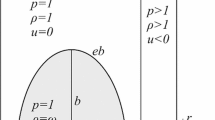Abstract
IN a recent communication, Baldwin and Precious1 have directed attention to the effect of withdrawal-rate on the hydrogen–oxygen second limit. Since they found this effect to be present in clean vessels and absent in vessels coated with potassium chloride, they favour an explanation which connects it with the participation of quadratic branching in the reaction. During our examination of the hydrogen–oxygen reaction2, we have also had occasion to study this phenomenon. Our own observations suggest that the effect is not directly connected with the presence of quadratic branching and support the alternative explanation, namely, that the net branching factor is reduced to zero by the products formed during the initial stages of the explosion.
Similar content being viewed by others
References
Baldwin, R. R., and Precious, R. M., Nature, 169, 290 (1952).
Egerton, A. C., and Warren, D. R., Proc. Roy. Soc., A, 204, 465 (1951). Warren, D. R., ibid., A, 211, 86, 96 (1952).
von Elbe, G., and Lewis, B., J. Chem. Phys., 9, 194 (1941).
Author information
Authors and Affiliations
Rights and permissions
About this article
Cite this article
EGERTON, A., WARREN, D. Effect of Withdrawal-Rate on Second Explosion Limits. Nature 170, 420–421 (1952). https://doi.org/10.1038/170420a0
Issue Date:
DOI: https://doi.org/10.1038/170420a0
- Springer Nature Limited





